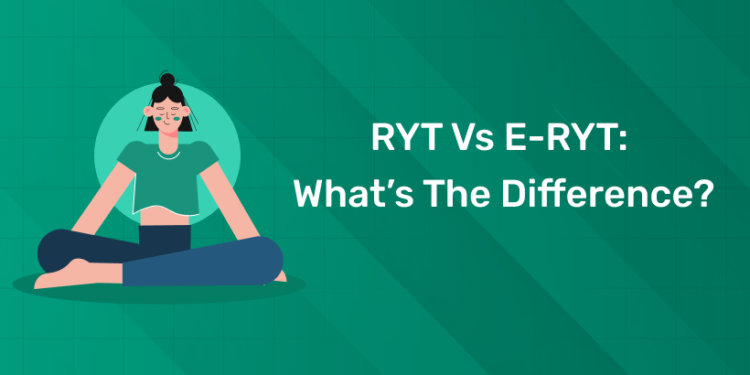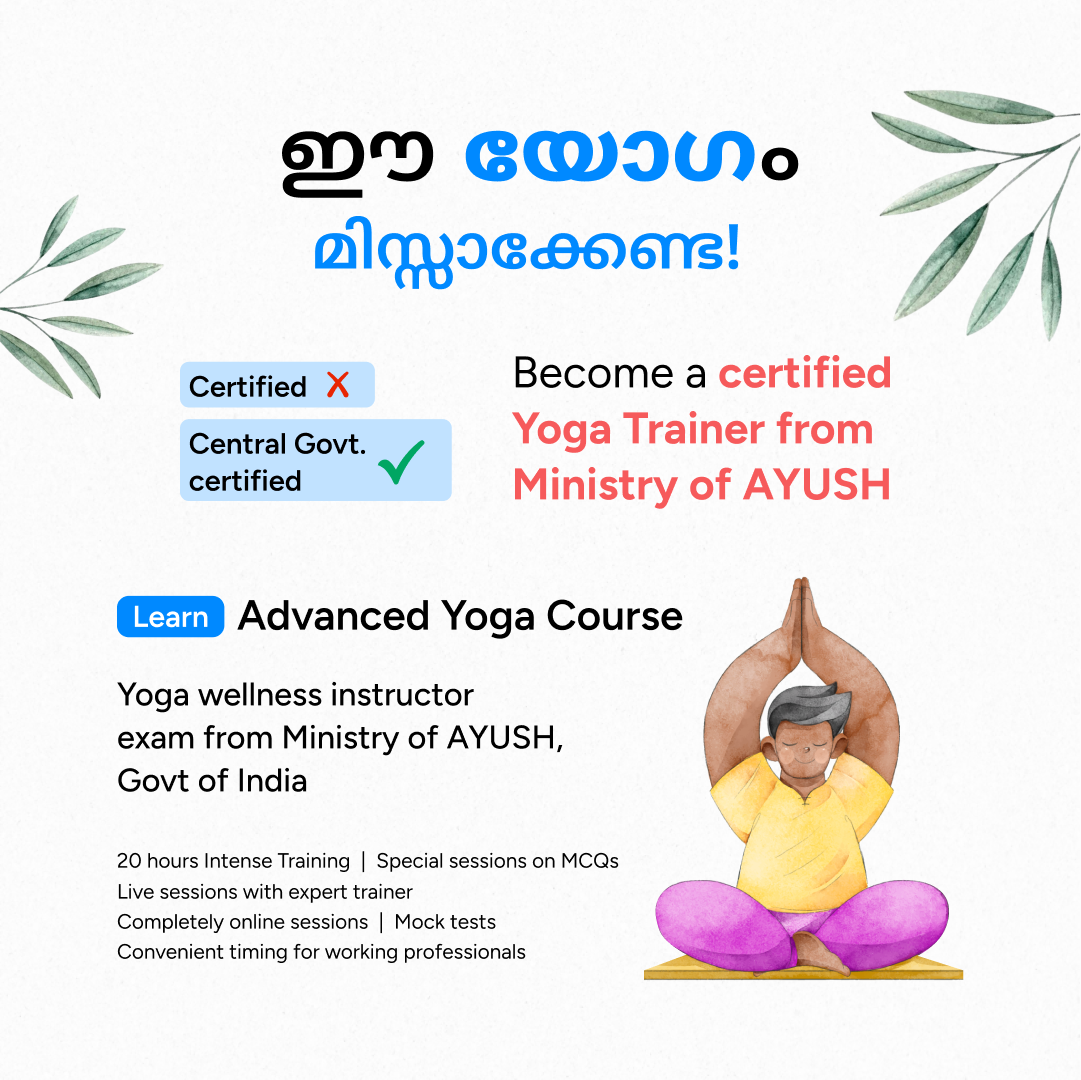Table of Contents
The practice of yoga is more than just a physical practice, it’s a journey into the body, mind and spirit through which balance is made. If you want to broaden your practice and teach others on this remarkable journey, teaching yoga is a powerful and rewarding option. But if you want to teach, you need your credentials.
RYT (Registered Yoga Teacher) and E-RYT (Experienced Registered Yoga Teacher) are terms used to describe the path to a career in yoga teaching or to describe a current teacher with a prior certification to explore if she or she is a qualified yoga teacher. Knowledge about this difference between these two certifications is important to make the right decision about your yoga learning path.
This post will explain the distinctions between RYT and E-RYT and why these are important in the present and current yoga world. To be an experienced beginner or a starting yoga teacher, knowledge of these three characteristics can help you begin your journey with certification. We will also discuss how Entri’s Yoga Course, the platform for yoga teachers, can help you gain certification.
Key Takeaways:
- First credentials are obtained after you take a Yoga Alliance-approved teacher training course.
- RYT (Registered Yoga Teacher) is the first credential you receive once you complete an AYT.
- E-RYT (Experienced Registered Yoga Teacher) also expands and also requires hundreds or thousands of teaching hours.
- You can become a professional yoga teacher through RYT, and E-RYT, like your trainer, helps you be a leader, mentor, and guide of future teachers.
- RYT and E-RYT are globally recognized and are an important part of training for a long-term yoga career. It depends on what you would like to teach in class, or the overall level of training you want.
- Entri Yoga Courses are structured classes that help students and teachers develop a path from beginner-level RYT to advanced E-RYT.
Get Certified, Get Confident! Join Our Yoga Teacher Training Course!
RYT vs E-RYT: Why This Question Matters
If you’ve ever searched for yoga teachers online or scrolled through Instagram bios, you’ve probably seen abbreviations like RYT-200 or E-RYT 500. For many, these terms look confusing, almost like secret codes in the yoga world.
The truth is, they aren’t just fancy letters. They represent a teacher’s journey, dedication, and level of experience.
But here’s the catch, many aspiring teachers wonder:
- Do I need to be an E-RYT to get a job?
- Will students trust me less if I only have RYT?
- How long does it take to progress from RYT to E-RYT?
These are valid questions. Today, yoga isn’t just a spiritual practice; it’s also a professional career path. Studios, online platforms, and wellness retreats increasingly look for teachers with certified credentials. So understanding the difference between RYT and E-RYT is crucial before you step into this field.
What Exactly Is an RYT?
1: Which of these is the primary goal of yoga practice?
Let’s start at the beginning.
RYT stands for Registered Yoga Teacher. It means you’ve completed a Yoga Alliance–approved teacher training program and registered yourself in their global directory.
For most teachers, the journey starts with a 200-hour Yoga Teacher Training Course (TTC). This is the standard foundation course where you study asanas, pranayama, yoga philosophy, anatomy, and teaching methods. Once you graduate, you can register as:
- RYT-200 (after 200 hours of training)
- RYT-500 (after 500 total hours of training, either in one program or a combination of 200H + 300H)
At this stage, you are fully qualified to teach classes at yoga studios, gyms, schools, or even online. It’s like getting your driver’s license; you’re certified to be on the road, but your skill will deepen with practice.
Become a Certified Yoga Instructor
Yoga Teacher Training Course by Entri App: Master authentic yoga techniques, earn certification, and build a successful career as a professional yoga instructor.
Join Now!What About E-RYT?
Now let’s talk about the next step.
E-RYT stands for Experienced Registered Yoga Teacher.
This title isn’t just about completing a training program. It’s about proving that you’ve spent years teaching real students and logged a required number of hours.
Yoga Alliance sets the benchmarks clearly:
- E-RYT 200 – Requires 200 hours of training plus at least 1,000 hours of teaching experience over 2 years.
- E-RYT 500 – Requires 500 hours of training plus at least 2,000 hours of teaching experience over 4 years.
So essentially, while RYT says: “I’m trained and ready to teach”, E-RYT says: “I’ve been teaching long enough to mentor others and even train future teachers.”
It’s a difference of maturity and depth.
RYT vs E-RYT: Breaking Down the Core Differences
| Feature | RYT (Registered Yoga Teacher) | E-RYT (Experienced Registered Yoga Teacher) |
| Requirement | Complete 200H or 500H TTC | Complete TTC + years of teaching practice |
| Experience | Entry-level | Advanced, with 1,000–2,000+ hours of teaching |
| Teaching Rights | Can teach classes | Can lead teacher training programs (TTCs) |
| Recognition | Certified instructor | Senior instructor, mentor, or lead trainer |
| Career Scope | Beginner to intermediate teaching roles | Leadership, teacher training, global recognition |
Think of it this way:
- RYT = Yoga teacher who has just started their career.
- E-RYT = Yoga teacher who has grown into a guide for other teachers.
Why Students Should Care
If you’re a student trying to choose a teacher, these labels matter.
An RYT-certified teacher is fully qualified to lead safe, effective classes. But an E-RYT often brings deeper wisdom, having seen hundreds of students with different body types, goals, and challenges.
For aspiring teachers, aiming for E-RYT status isn’t about showing off. It’s about becoming the kind of teacher who can inspire, mentor, and train others.
Become a Certified Yoga Instructor
Yoga Teacher Training Course by Entri App: Master authentic yoga techniques, earn certification, and build a successful career as a professional yoga instructor.
Join Now!From RYT to E-RYT: The Journey
- Step 1 – Start with RYT 200
Your foundation begins here. Most teachers start their careers after completing a 200H TTC. - Step 2 – Begin Teaching Actively
Gain hands-on experience by teaching friends, family, or community classes. The hours you log here are vital. - Step 3 – Upskill to RYT 500
Many teachers upgrade by completing a 300H advanced TTC - Step 4 – Accumulate Teaching Hours
Yoga Alliance requires 1,000+ hours for E-RYT 200 and 2,000+ for E-RYT 500. - Step 5 – Register as E-RYT
Once you meet the requirements, you can apply to Yoga Alliance for the E-RYT credential.
This process ensures that yoga teachers aren’t just trained—they’re also tested by real-world teaching.
Common Misconceptions
❌ “E-RYT is a different training program.”
✅ No, it’s a credential earned through teaching experience after training.
❌ “You can’t make a career as an RYT.”
✅ Absolutely untrue. Many successful teachers work as RYTs.
❌ “RYT teachers aren’t as good as E-RYTs.”
✅ Not necessarily. A passionate RYT with fresh skills can sometimes connect better with students than a senior teacher.
Why These Credentials Matter in Today’s Yoga Industry
In a world where yoga is becoming mainstream, credentials help build trust and credibility.
- Studios and retreats often prefer certified teachers.
- Students feel assured they’re learning from someone recognized globally.
- International opportunities often require Yoga Alliance registration.
RYT and E-RYT are like stepping stones—each essential for building a sustainable, long-term career in yoga teaching.
How Entri Yoga Course Fits Into This Journey
For many aspiring teachers, the biggest challenge is knowing where to start. That’s where structured learning programs come in.
The Entri Yoga Course is designed to:
- Equip students with foundational skills for RYT certification.
- Offer flexible, guided learning for working professionals.
- Prepare teachers to eventually pursue advanced certifications like E-RYT.
- Provide practical, real-world teaching strategies to build confidence.
With expert mentors and step-by-step guidance, Entri helps bridge the gap between being a passionate yoga student and a certified professional teacher.
RYT vs E-RYT: Which Should You Choose?
- If you’re just starting: Go for RYT 200. It gives you the credibility to teach right away.
- If you’re committed to long-term growth: Aim for RYT 500 and gradually move towards E-RYT.
- If your dream is to train teachers and run TTCs: E-RYT is your ultimate goal.
Conclusion
At the end of the day, it’s about experience, and that difference between RYT and E-RYT is not that it is better; it is that experience.
RYT gives you the wings to begin teaching. E-RYT gives you the support to guide and mentor others. These are valid, respected, and necessary at different stages of your career.
The more than you may be qualified to do is your practice, consistency with teaching, and ability to connect with students.
If you are just starting out, take it one step at a time. Start with RYT, then convert to confidenc,e and then E-RYT. Entri Yoga Courses will give you all the tools you need to become an accomplished yoga teacher who affects the lives of people around the world.
Your yoga journey is a unique one. Just a milestone. It is your energy that transforms your body to the mat.
Become a Certified Yoga Instructor
Yoga Teacher Training Course by Entri App: Master authentic yoga techniques, earn certification, and build a successful career as a professional yoga instructor.
Join Now!Frequently Asked Questions
What does RYT stand for in yoga?
RYT stands for Registered Yoga Teacher. It means a yoga teacher has completed a Yoga Alliance–approved training program, usually 200 or 500 hours.
What is the difference between RYT and E-RYT?
An RYT is a certified yoga teacher, while an E-RYT (Experienced Registered Yoga Teacher) has additional teaching experience—1,000 to 2,000+ hours, allowing them to train future teachers.
Do I need to be an E-RYT to get a yoga teaching job?
No. An RYT credential is enough to start teaching classes in studios, schools, or online. E-RYT is more for teachers who want to lead TTCs or mentor other teachers.
How many hours of training are required for RYT certification?
The most common pathway is RYT-200, which requires 200 hours of training. You can also pursue RYT-500, which includes an additional 300 hours of advanced training.
How many hours of teaching are needed for E-RYT certification?
To register as an E-RYT 200, you need 1,000+ teaching hours. For E-RYT 500, you need 2,000+ hours, along with a minimum number of years teaching.
Is RYT or E-RYT recognized worldwide?
Yes. Both credentials are globally recognized under Yoga Alliance, making them valuable for international teaching opportunities.
Can a beginner yoga teacher become E-RYT?
Not immediately. You first need to register as RYT, gain teaching experience, and then apply for E-RYT after completing the required hours.
Why is E-RYT considered more advanced than RYT?
Because E-RYT proves that the teacher not only trained but also taught extensively, gaining hands-on experience with many students and scenarios.
How can Entri’s Yoga Course support my journey to RYT or E-RYT?
Entri’s Yoga Course provides structured training, expert mentorship, and step-by-step guidance to help yoga enthusiasts grow from RYT certification to E-RYT recognition.


























